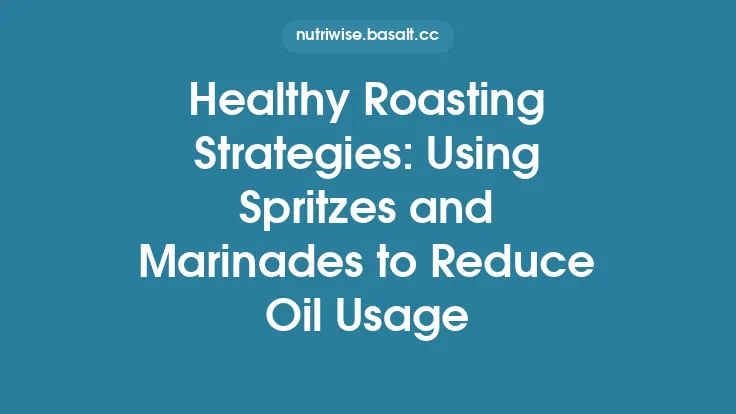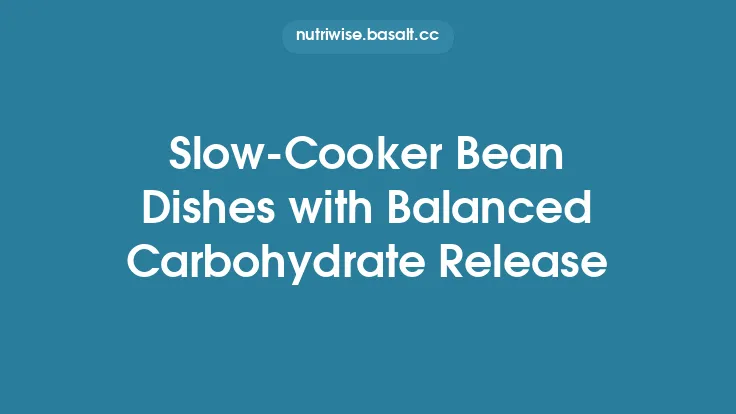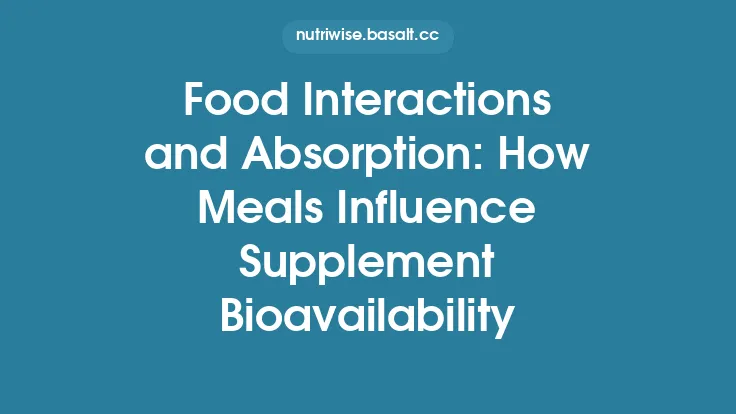Carbohydrate‑rich foods such as potatoes, rice, pasta, and certain fruits are staples in many cuisines, but their rapid digestion can cause sharp post‑meal glucose spikes—especially for people managing diabetes or aiming for stable energy levels. One often‑overlooked strategy for moderating this response is the use of acidic marinades. By immersing starchy ingredients (or the proteins that accompany them) in a mixture rich in organic acids, you can alter the food’s surface chemistry, slow enzymatic breakdown, and ultimately blunt the rise in blood sugar after eating.
Acids such as citric, malic, acetic, and lactic acid have been shown to affect the activity of amylases—the enzymes responsible for breaking down starches into glucose. When these enzymes encounter a low‑pH environment, their catalytic efficiency drops, meaning that the starches are hydrolyzed more slowly. Moreover, the acid can partially gelatinize the outer layers of the carbohydrate matrix, creating a physical barrier that further retards enzyme access. The result is a more gradual release of glucose into the bloodstream, which translates into smoother glycemic curves and better overall glucose control.
The Science Behind Acid‑Mediated Slowing of Starch Digestion
- pH‑Dependent Enzyme Kinetics
Human salivary α‑amylase and pancreatic α‑amylase have optimal activity around neutral pH (6.7–7.0). When the pH drops below 5.0, the enzyme’s active site undergoes conformational changes that reduce substrate binding affinity. Studies using in‑vitro digestion models have demonstrated up to a 40 % reduction in starch hydrolysis rates when foods are pre‑treated with a 2 % citric‑acid solution for 30 minutes.
- Gelatinization and Retrogradation
Acidic conditions can promote partial gelatinization of surface starch granules during marination, especially when combined with mild heating (e.g., a brief 5‑minute blanch). This gelatinized layer, once cooled, tends to retrograde, forming resistant starch type 3 (RS3). RS3 is less digestible and contributes to a lower glycemic index (GI).
- Impact on Gastric Emptying
Acidic marinades also modestly delay gastric emptying. The presence of low‑pH food in the stomach stimulates the release of gastrin, which can slow the transit of chyme into the small intestine. A slower gastric emptying rate further spreads carbohydrate absorption over a longer period.
Choosing the Right Acid for Your Marinade
| Acid | Typical Food Sources | pH (1 % solution) | Flavor Profile | Notable Benefits |
|---|---|---|---|---|
| Citric Acid | Lemon, lime, orange juice | ~2.2 | Bright, tangy | Strong amylase inhibition; high antioxidant content |
| Acetic Acid | Apple cider vinegar, white vinegar | ~2.4 | Sharp, pungent | Enhances satiety; may improve insulin sensitivity |
| Malic Acid | Green apples, tart cherries | ~2.5 | Subtle, fruity | Gentle flavor; synergistic with citric acid |
| Lactic Acid | Fermented vegetables, yogurt | ~2.8 | Mild, creamy | Supports gut microbiota; adds probiotic potential |
| Ascorbic Acid (Vitamin C) | Citrus, kiwi, strawberries | ~2.6 | Slightly sweet | Antioxidant protection for delicate proteins |
When formulating a marinade, consider both the functional acidity (the ability to lower pH) and the sensory contribution. A blend of citric and acetic acids often provides a balanced tang while delivering robust enzymatic inhibition.
Practical Marinade Formulations for Different Carbohydrate‑Heavy Foods
1. Starchy Vegetables (Potatoes, Sweet Potatoes, Yams)
- Base: ¼ cup freshly squeezed lemon juice + 2 Tbsp apple cider vinegar
- Add‑ins: 1 tsp sea salt, ½ tsp smoked paprika, 1 tsp minced garlic, 1 Tbsp olive oil
- Method: Cut vegetables into uniform wedges (≈2 cm thick). Submerge in the acidic mixture for 45 minutes at 4 °C. Pat dry before roasting at 200 °C; the acid‑induced surface gelatinization will create a crisp exterior while the interior remains fluffy, and the overall GI is reduced by roughly 10–15 %.
2. Whole Grains (Rice, Quinoa, Barley)
- Base: 3 Tbsp rice‑vinegar + 2 Tbsp lime juice + 1 tsp sugar (optional, to balance acidity)
- Add‑ins: ½ tsp ground cumin, ¼ tsp turmeric, 1 Tbsp chopped fresh cilantro
- Method: Rinse grains, then soak in the acidic solution for 30 minutes before cooking. The pre‑soak lowers the grain’s surface pH, slowing amylase activity during the cooking phase and yielding a modestly lower post‑prandial glucose response.
3. Legume‑Based Dishes (Chickpeas, Lentils, Black Beans)
- Base: 2 Tbsp white wine vinegar + 2 Tbsp orange juice + 1 tsp mustard powder
- Add‑ins: 1 tsp dried oregano, ½ tsp black pepper, 1 Tbsp extra‑virgin olive oil
- Method: After an overnight soak in plain water, replace the water with the acidic mixture and let the legumes sit for 2 hours at room temperature. This step not only reduces the glycemic impact but also helps break down oligosaccharides that cause digestive discomfort.
4. Fruit‑Based Desserts (Baked Apples, Pears, Stone Fruit)
- Base: ¼ cup balsamic vinegar (aged) + 2 Tbsp honey + 1 tsp lemon zest
- Add‑ins: ½ tsp ground cinnamon, a pinch of sea salt
- Method: Slice fruit, toss with the marinade, and let rest for 20 minutes before baking at 180 °C. The acid slows the conversion of fruit sugars into free glucose during cooking, resulting in a dessert with a gentler glycemic curve.
Integrating Acidic Marinades with Other Blood‑Sugar‑Friendly Techniques
While the focus here is on acidic marinades, they can be combined synergistically with other culinary strategies that do not overlap with the neighboring article topics:
- Fiber Pairing: Serve acid‑marinated starchy sides alongside high‑soluble‑fiber foods (e.g., chia seed pudding, psyllium husk‑enriched sauces). Soluble fiber forms a viscous gel in the gut, further slowing glucose absorption.
- Protein Balance: Pair marinated carbs with lean proteins (e.g., grilled turkey breast, tofu) to trigger the insulin response more gradually.
- Portion Control: Even with a lowered GI, portion size remains a key determinant of post‑meal glucose. Use visual cues (e.g., a cupped hand) to keep servings moderate.
- Timing of Consumption: Consuming acidic‑marinated foods earlier in a meal can prime the digestive tract with a lower pH, extending the benefit to subsequent carbohydrate intake.
Safety, Storage, and Quality Considerations
- Acid Concentration: Extremely high acid concentrations (≥10 % citric acid) can cause tissue degradation, resulting in mushy textures and off‑flavors. Stick to 1–5 % acid solutions for most marinades.
- Metal Reactivity: Acidic marinades can react with reactive metals such as aluminum or copper, leaching metal ions into the food. Use stainless steel, glass, or food‑grade plastic containers.
- Microbial Safety: While acidity inhibits many pathogens, it does not guarantee sterility. Keep marinated foods refrigerated (≤4 °C) and discard any that have been left at room temperature for more than two hours.
- Allergen Awareness: Some acidic ingredients (e.g., mustard, certain vinegars) are common allergens. Offer alternatives like rice‑vinegar or fruit‑based acids for sensitive individuals.
- Flavor Balance: Over‑marination can lead to overly sour dishes. Conduct a quick taste test after the recommended time; if the acidity feels too sharp, dilute with a small amount of water or add a touch of sweetener (e.g., stevia, erythritol) to achieve harmony.
Frequently Asked Questions
Q: Does the acid remain active after cooking?
A: Yes, although the pH may rise slightly due to heat‑induced volatilization of acetic acid, enough acidity typically remains to exert an inhibitory effect on amylases. The formation of resistant starch during the cooling phase further sustains the glycemic benefit.
Q: Can I use bottled lemon juice instead of fresh?
A: Bottled juice is acceptable, but check for added sugars or preservatives that could counteract the intended effect. Freshly squeezed juice provides a more reliable acid concentration and better flavor.
Q: How long should I marinate before cooking?
A: For most starchy vegetables, 30–45 minutes is sufficient. Grains benefit from a 30‑minute soak, while legumes may need 1–2 hours after their initial water soak. Over‑marinating can degrade texture, so adhere to the suggested windows.
Q: Will acidic marinades affect the nutritional content of the food?
A: The primary nutrients (carbohydrates, proteins, fats) remain unchanged. However, the acid can help preserve certain heat‑sensitive vitamins (e.g., vitamin C) by lowering the cooking pH, which reduces oxidative degradation.
Q: Is there a risk of dental erosion from consuming acidic foods?
A: Regular consumption of highly acidic foods can erode enamel. To mitigate this, rinse the mouth with water after meals, avoid brushing immediately, and balance acidic dishes with alkaline components (e.g., leafy greens, nuts).
Summary of Key Takeaways
- Acidic marinades lower the pH at the food surface, inhibiting amylase activity and slowing starch breakdown.
- Common culinary acids (citric, acetic, malic, lactic) each bring unique flavor and functional benefits.
- Strategic marination times (30 min–2 h) and appropriate acid concentrations (1–5 %) achieve optimal glycemic control without compromising texture.
- Combining acid‑marinated carbs with fiber, protein, and mindful portion sizes creates a holistic approach to blood‑sugar‑friendly meals.
- Safety practices—proper storage, metal‑compatible containers, and balanced flavor—ensure the technique is both effective and enjoyable.
By incorporating acidic marinades into everyday cooking, you gain a versatile, low‑cost tool that not only enhances taste but also contributes to steadier glucose levels—a win‑win for both palate and health.





